Abstract
The slow swelling rate of styrene–butadiene–styrene (SBS) in asphalt prolongs the modification process and increases energy consumption. This study proposes a novel method using benzoyl peroxide (BPO) and benzoyl methane (BPA) to accelerate SBS swelling through a radical initiation–capture mechanism. BPO generates free radicals that relax the SBS network, while BPA captures excess radicals, maintaining system stability. Molecular dynamics simulations based on the COMPASS II force field were used to analyse diffusion, radius of gyration, and solubility parameters, revealing that BPO/BPA improved SBS–asphalt compatibility and increased the diffusion coefficient by 76%. Macroscopic viscosity tests confirmed that the swelling time decreased by 40% and equilibrium viscosity increased by 39% compared with the conventional process. The modified asphalt also exhibited enhanced high- and low-temperature performance and ageing resistance. This simple and efficient synergistic technique provides a promising approach for the rapid preparation of SBS-modified asphalt and offers practical potential for industrial production.
1. Introduction
SBS-modified asphalt is widely used for its superior rutting and cracking resistance. However, the swelling of SBS in asphalt is inherently slow, requiring long mixing times and high energy input. Conventional accelerators, such as plasticisers or reactive modifiers, mainly reduce viscosity or promote limited diffusion, often compromising long-term performance [1,2,3].
During swelling, methods such as high-speed shearing, stirring, or ultrasonic dispersion are used to ensure that the modifier is fully dispersed into the asphalt matrix. The modifier gradually absorbs the lighter components from the asphalt, causing the molecular chains to unfold and form an expanded structure. This stage may be accompanied by minor dissolution and molecular interactions, with the swollen particles beginning to form a network structure. The entire swelling process takes approximately 3–5 h, as the longer molecular chains of SBS require more time for absorption and expansion. Higher temperatures accelerate the swelling rate, but excessively high temperatures (>200 °C) may cause asphalt ageing or degradation of the modifier. Overall, the swelling rate of SBS is relatively slow. If the swelling time is insufficient, it may result in inadequate dispersion of the modifier, affecting the modification effect; if the swelling time is too long, it may cause asphalt ageing.
Despite extensive studies on swelling kinetics and composite modification, few approaches have addressed the simultaneous acceleration and stabilisation of the SBS swelling process. To overcome this limitation, this study introduces a dual-function system of BPO and BPA, which regulates radical reactions to achieve both faster diffusion and improved compatibility. The research combines molecular dynamics simulation and experimental validation to establish a new swelling acceleration mechanism and preparation process for SBS-modified asphalt [4,5,6].
2. Accelerated Swelling Mechanism of BPO and BPA
Dibenzoyl peroxide, also known as benzoyl peroxide, commonly referred to as initiator BPO, is an organic compound with the chemical formula C14H10O4. BPO decomposes at lower temperatures (approximately 80–100 °C), producing two benzoyl radicals; benzoyl radicals are highly reactive and can initiate various radical reactions. BPO is commonly used as an initiator for polymer materials, initiating radical polymerisation reactions by generating radicals; under controlled conditions, BPO can act as an antioxidant, slowing material ageing through appropriate radical initiation. Dibenzoylmethane has the molecular formula C15H12O2. In actual industrial applications, BPA serves as a co-stabiliser in calcium/zinc hydroxide stabiliser systems. During the production and use of plastic products, it captures free radicals to maintain the physical and chemical stability of the material [7,8]. Figure 1 and Figure 2 show the molecular structure diagrams of benzoyl peroxide and benzoyl methane.
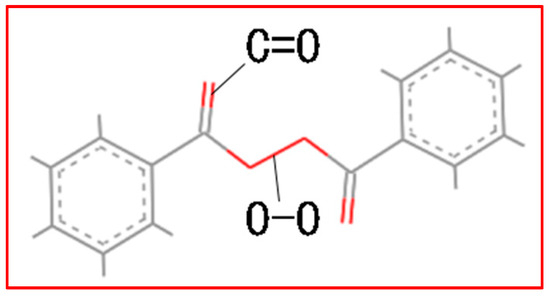
Figure 1.
Dibenzoyl peroxide.
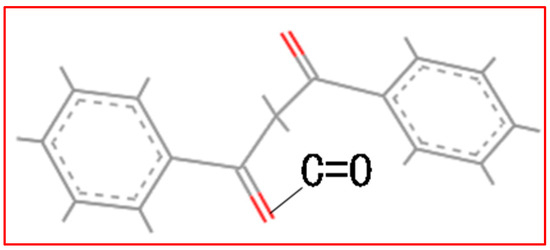
Figure 2.
Dibenzoylmethane.
The synergistic effect of benzoyl peroxide (BPO) and benzoyl methane (BPA) significantly accelerates the swelling rate of SBS in asphalt through chemical reactions and physical interactions while ensuring the stability and modification effect of the system. The reaction mechanism can be divided into the following steps:
BPO undergoes thermal decomposition under high-temperature conditions, generating free radicals. The specific reaction is as follows:
The generated benzoic acid radicals () possess strong oxidising properties and high reactivity, reacting with the polybutadiene or styrene groups in SBS to disrupt the physical cross-linking network of the SBS molecular chains, opening up the cross-linking points of the molecular chains, reducing intermolecular forces, and enhancing its ability to absorb light components of the matrix asphalt; this reduces the viscosity of the matrix asphalt, promotes the diffusion of light components, facilitates the rapid penetration of light components into the SBS microstructure, and further promotes the swelling process. The molecular structure of BPA contains active carbonyl groups (C=O) and benzene rings, which can efficiently capture excess free radicals. After capturing free radicals, stable benzoic acid products are formed, inhibiting the side reactions of excess free radicals. This prevents SBS from undergoing excessive cross-linking or decomposition in the system, ensuring the uniformity and stability of the swelling process and avoiding degradation of asphalt performance [9]. The synergistic mechanism of BPO and BPA accelerating swelling is shown in Figure 3.
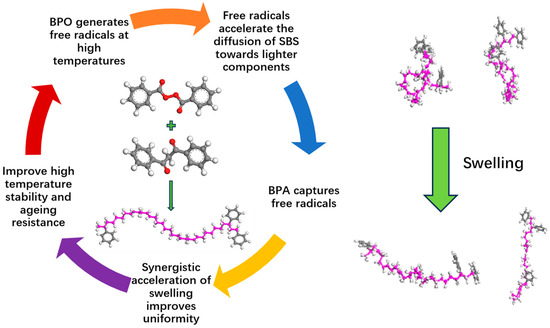
Figure 3.
Mechanism of accelerated swelling of BPO and BPA and SBS swelling process.
The synergistic effect of BPO and BPA promotes the breakage of SBS molecular chains and network relaxation. The free radicals generated by BPO disrupt the SBS network structure, causing the SBS molecular chains to relax and expose more adsorption sites, thereby promoting the absorption of light components. The synergistic effect of BPO and BPA promotes the diffusion and uniform distribution of light components. The chemical reactions induced by BPO allow for asphalt light component molecules to more easily diffuse into the interior of SBS particles. The stabilising effect of BPA inhibits excessive radical reactions, maintaining uniformity in the system during the swelling process and preventing local cross-linking or decomposition. The synergistic effect of BPO and BPA enables the dynamic regulation of viscosity changes. During the initial reaction phase, BPO reduces the viscosity of the base asphalt, facilitating the penetration of light components. In the middle to late reaction phases, after BPA captures free radicals, it enhances system stability, causing the overall viscosity of the asphalt to gradually increase and stabilise [10]. The synergistic effect of BPO and BPA reduces the ageing effect of free radicals on asphalt components. At the same time, the stable products generated have an antioxidant effect, delaying the ageing process of asphalt [11]. Compared with conventional plasticisers or acid-based modifiers that rely on viscosity reduction or chemical grafting, the BPO–BPA system introduces a controllable radical-based synergistic mechanism. This allows for the simultaneous acceleration and stabilisation of SBS swelling, which represents a new modification route beyond conventional viscosity-reduction strategies.
3. Asphalt Swelling Molecular Dynamics Model Based on BPO and BPA
3.1. Establishment of Molecular Dynamics Model for SBS–Pre-Swelling Agent Blend System
Studying the swelling characteristics of modified asphalt from a microscopic perspective requires the construction of a mesoscopic model. Using Materials Studio 2020 software, monomer models of asphalt components, modifiers, and accelerated swelling agents were constructed based on a specific molecular weight, and these models were combined into a mixed model. Using molecular dynamics methods, the interactions between SBS modifiers and accelerated swelling agents during the swelling process at swelling temperatures, as well as their influencing factors, were investigated.
Asphalt is an amorphous polymer composed of four components: saturated fractions, aromatic fractions, resins, and asphaltic fractions. When constructing an asphalt model, representative molecules for each component should be selected first. However, the essence of SBS and asphalt modification is swelling, and this process is primarily physical in nature, with minimal chemical reactions. In the molecular structure construction of asphalt, physical interactions play a dominant role. However, since the four-component twelve-molecule model proposed by Li and Greenfield better describes the physical properties, rheological properties, and mechanical properties of asphalt, this model was selected for this study. The twelve molecules constituting the model are depicted in Figure 4.
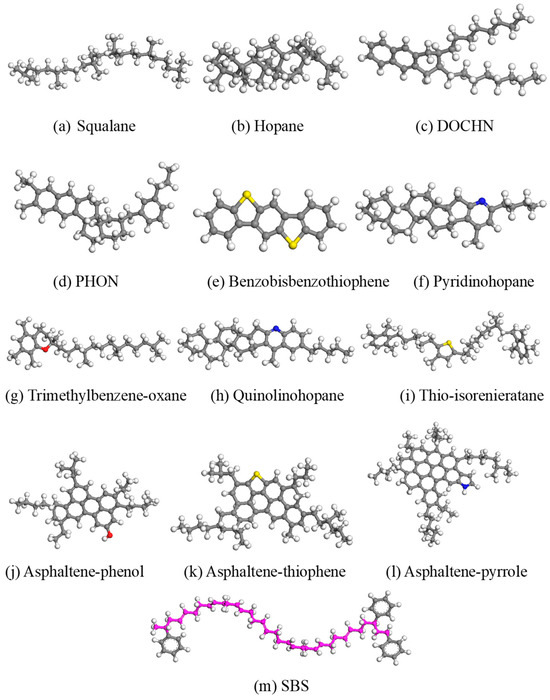
Figure 4.
Asphalt twelve-molecule model.
The molecular structures of BPO and BPA and the molecular formula of the pre-swelling agent aromatic oil are shown in Figure 5.

Figure 5.
Structural formulas of BPO, BPA, and aromatic oils.
First, the diffusion behaviour of SBS modifiers in pre-swollen aromatic oils was studied to preliminarily assess their swelling acceleration effect. The ‘Establish Layer’ option was used to establish an interlayer model, and the above-mentioned mixed model was selected as the layer model. The upper, middle, and lower layers were SBS, aromatic oil fractions, and SBS, respectively. The two established SBS and aromatic oil primary models are shown in Figure 6.
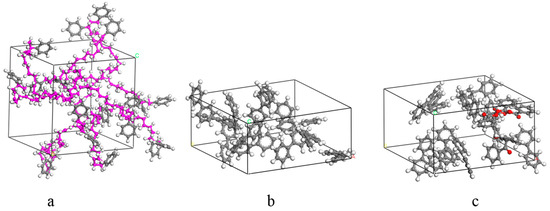
Figure 6.
Primary layer model ((a): SBS molecule; (b): aromatic oil component; (c): aromatic oil and BPO/BPA blend system).
The COMPASS II force field was selected because it provides accurate parameterisation for organic molecular systems containing aromatic rings, carbonyl groups, and polymer chains, which are typical in asphalt, SBS, and BPO/BPA molecules. Previous studies have demonstrated that COMPASS II yields reliable diffusion and cohesive energy results in bitumen–polymer–additive simulations, making it well-suited for the asphalt–SBS–additive system investigated here.
We combined the SBS model, aromatic oil fraction, and aromatic oil fraction model with added BPO and BPA into two layer models. We selected the NPT ensemble to simulate the molecular dynamics process of the established system interaction layers at a temperature of 453.15 K in the COMPASS II force field. The middle aromatic oil layer of the layer model moves freely between the upper and lower layers of the SBS molecular clusters, simulating the swelling process of modified asphalt. Based on molecular dynamics simulations, the feasibility of using an external accelerated swelling agent to promote SBS swelling was confirmed based on diffusion characteristics. During dynamic simulations, the intermediate layer of each system remains in a state of free movement, and the interaction interfaces of each system exhibit different states, representing the microscopic mechanical behaviour between the two distinct molecular groups. A mixed model with a density of 0.6 g/cm3 was established and geometrically optimised. All mixed models were annealed using an intelligent algorithm with annealing options to release the energy generated during model establishment. The initial annealing temperature was 300 K, and the intermediate temperature was 800 K, completing 15 cycles of operation. After annealing, 15 configurations were obtained. The configuration with the highest energy consumption (i.e., the most stable configuration) was used to perform 100 ps of relaxation on each system using the NVT ensemble, followed by 300 ps of relaxation using the NPT ensemble. The different states of the two systems during the four processes are shown in Figure 7.
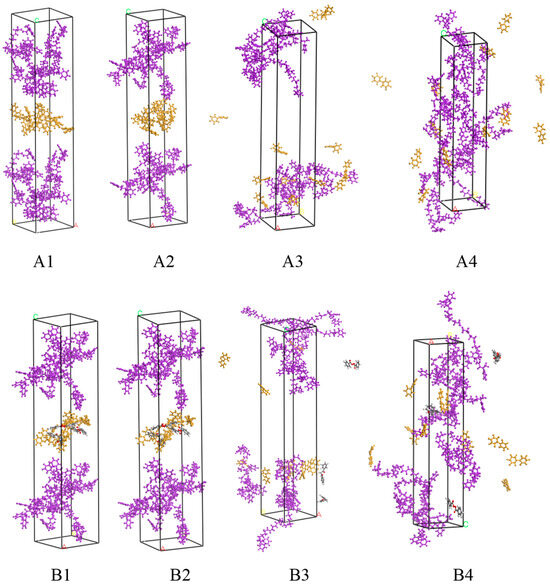
Figure 7.
Molecular dynamics simulation of SBS–aromatic oil blend system ((A1–A4): initial model of conventional system, geometrically optimised model, NVT equilibrium completed, NPT contraction end state; (B1–B4): initial model of accelerated swelling system, geometrically optimised model, NVT equilibrium completed, NPT contraction end state).
3.2. Establishment of a Molecular Dynamics Model for Modified Asphalt Systems
To simulate the swelling behaviour in real asphalt, an SBS-modified asphalt model needs to be established for research purposes. Two SBS-modified asphalt models were established: one with an accelerated swelling system incorporating BPO and BPA and another with a conventional system. All 12 types of molecules were placed in a periodic box with an initial density of 0.6 g/cm3 to prevent molecular chains from twisting, thereby establishing an asphalt model with randomly distributed molecules. The molecular composition and number of molecules are shown in Table 1.

Table 1.
Model molecular composition and molecular quantity.
During annealing, an initial temperature of 300 K and an intermediate temperature of 800 K were selected to complete 15 cycles. After annealing, subsequent operations were performed on both models using the most stable configurations. The models were heated to 453.15 K using the Nose–Hoover thermal bath method and run for 100 ps under NVT ensemble conditions. During the run, the system’s energy gradually reached a stable state over time, and the asphalt molecules transitioned from their initial state to an equilibrium state at the target temperature. Subsequently, the asphalt molecule model was placed under NPT ensemble conditions, with the temperature set to 453.15 K and the pressure set to p = 1.0 atm. After running for 300 ps, the asphalt molecule system contracted to a stable state, reaching its true density. The various states of the asphalt model are shown in Figure 8.
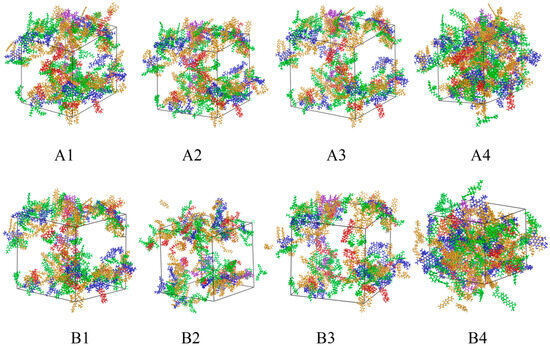
Figure 8.
Molecular dynamics simulation of modified asphalt system ((A1–A4): initial model of conventional system, geometrically optimised model, NVT equilibrium completed, NPT contraction end state; (B1–B4): initial model of accelerated swelling system, geometrically optimised model, NVT equilibrium completed, NPT contraction end state).
4. Selection of Parameters for Evaluating Accelerated Swelling Effects
4.1. Microscopic Evaluation Parameters for Accelerated Swelling Effect
The synergistic effect of BPO and BPA promotes the diffusion and uniform distribution of light components. The chemical reactions induced by BPO make the light components of asphalt diffuse more easily into the interior of SBS particles. Thus, swelling is essentially a molecular diffusion process. In the SBS–aromatic oil blend system, swelling is the process of aromatic oil components diffusing into SBS chains. In modified asphalt systems, SBS swelling is the process of light components (aromatic hydrocarbons, saturated hydrocarbons) in asphalt diffusing into SBS chains. MSD directly reflects the migration ability of molecules/chain segments. The steeper the MSD slope, the faster the diffusion and the higher the swelling rate.
Further analysis requires quantitative calculations based on various data obtained from kinetic simulations. The mean square displacement (MSD) is used to study the diffusion behaviour of particles in the SBS layer. MSD is the square of the difference between the displacement of an atom and the average displacement of all atoms and can be calculated using Formula (1).
In the equation, refers to the displacement of the particle at time t; refers to the displacement of the particle at the initial time; and <> refers to the average value of all atoms in the group. For the diffusion coefficients of each component, they are calculated using Formula (2).
The stabilising effect of BPA inhibits excessive free radical reactions, maintaining uniformity in the system during the swelling process and preventing local cross-linking or decomposition. This indicates that swelling depends on the intermolecular forces between SBS and asphalt components. Therefore, RDF is a standard structural analysis tool that can calculate the spatial correlation of specific atom pairs (such as SBS–aromatic oil components). The position of the first peak corresponds to the reaction distance, and the height of the first peak corresponds to the reaction intensity. By analysing the RDF between SBS and aromatic oil components, it can be verified whether they are bound to the target molecules.
The RDF curve (radial distribution function curve) is a tool for analysing the local density distribution characteristics of atoms, molecules, or particles in space, primarily used to reveal the microscopic structural features of materials and the patterns of intermolecular interactions. By statistically analysing the probability density of particle distances, the RDF curve can quantitatively describe the structural orderliness of a substance at different distance scales. In this example, the RDF curve can describe the interaction strength and compatibility between SBS and pre-swollen agent molecules. The radius of gyration (Rg) is an important parameter for measuring molecular structural compactness and dynamic changes. It primarily analyses molecular behaviour through its numerical value and trend. If the Rg value is large, this indicates that the molecule is significantly unfolded, possibly in a denatured state or with a long-chain flexible structure. In molecular dynamics simulations, Rg is commonly used to assess molecular conformational stability, solvent effects, and interactions. Formulas (3) and (4) are used to calculate the distribution and Rg values:
where Rg denotes the radius of gyration of the molecule, mi denotes the mass of the i-th atom in the molecule, Ri denotes the distance from the i-th atom to the centre of mass of the molecule, and N denotes the number of atoms in the molecule.
The cohesive energy density (CED) is the energy E required per unit volume for a substance to overcome intermolecular forces and vaporise. It is a physical quantity that characterises the strength of intermolecular forces, primarily reflecting the interactions between groups. Generally, the greater the polarity of the groups within a molecule, the stronger the intermolecular forces, and thus the higher the corresponding cohesive energy density. Conversely, if the cohesive energy density is low, the intermolecular forces are weaker, and the material exhibits better compatibility. The solubility parameter δ is a physical constant used to measure the solubility of materials, defined as the square root of the cohesive energy density of the material. It is used to predict the mutual solubility between solvents and solutes or polymers. When the difference in δ values between the solvent and solute is less than 1.0 (J/cm3)0.5, the two are easily miscible; the larger the difference, the poorer the compatibility. In modified asphalt systems, cohesive energy density and solubility parameters can be used to evaluate the compatibility of BPO/BPA with the various components of modified asphalt. Formulas (5) and (6) are used to calculate cohesive energy density and solubility parameters.
where Hv is the enthalpy of vaporisation, R is the gas constant, T is the thermodynamic temperature, and V is the molar volume.
4.2. Macro Evaluation Parameters for Accelerated Swelling Effect
The synergistic effect of BPO and BPA enables the dynamic regulation of viscosity changes. During the later stages of the reaction, BPA captures free radicals, enhancing system stability and causing the overall viscosity of the asphalt to gradually increase and stabilise. Therefore, the high-temperature performance of modified asphalt is directly related to viscosity, which serves as the core indicator for accelerated swelling macroscopic properties. An increase in viscosity indicates a more complete network structure, while a higher rate of viscosity increase reflects accelerated swelling. An increase in the equilibrium viscosity value indicates a more compact network structure. Viscosity is calculated using Equation (7).
where is the shear force and is the shear rate.
Technical parameters such as asphalt penetration, softening point, and ductility, as well as test parameters for thermal–oxidative ageing and pressure ageing, can all be used to evaluate the macro-performance of accelerated swelling modified asphalt and conventional modified asphalt. Therefore, this paper also conducts tests and uses the above test data to evaluate the macro-performance of accelerated swelling.
5. Analysis of Accelerated Swelling Effects Based on BPO and BPA
5.1. Analysis of Accelerated Swelling Micro-Effects
For the SBS–aromatic oil blend system, the diffusion coefficient D can be represented by the approximate slope of 1/6 MSD. Therefore, by fitting and calculating the MSD curve, the relevant diffusion coefficient can be obtained. The final 100 ps MSD data with a relatively stable slope after NPT ensemble equilibrium is used for fitting and calculation, as shown in Figure 9 and Figure 10.
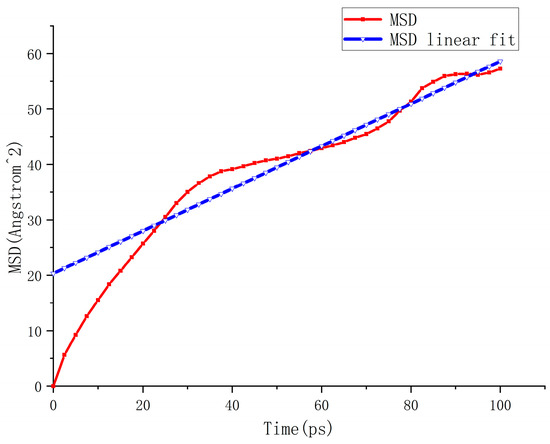
Figure 9.
Mean square displacement (MSD) curve of the conventional SBS–aromatic oil system.
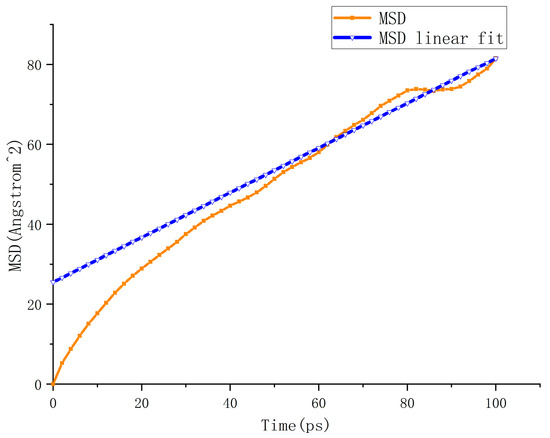
Figure 10.
MSD curve of the BPO/BPA-accelerated SBS–aromatic oil system.
According to the simulation results, the two curves represent the MSD for the last 100 ps, and the two blue straight lines represent the linear fitting lines of the two sets of MSD data. Figure a shows the diffusion system of SBS without the addition of an accelerated swelling agent, while Figure b shows the diffusion system of SBS after the addition of BPO and BPA. The diffusion coefficients of SBS in the pre-swelling agent under the two conditions were calculated using the slopes of the linear fit lines of the two sets of MSD data, yielding values of 0.0638 and 0.0933, respectively. The goodness-of-fit coefficients for the lines were 0.9556 and 0.9544, respectively. The linear relationship of MSD is evident, indicating that BPO and BPA accelerate the diffusion of SBS in the pre-swelling agent, suggesting that using BPO and BPA for accelerated swelling is feasible.
The centre of mass of SBS and the centre of mass of aromatic oil fractions were selected under the two conditions to plot radial distribution function (RDF) images, and the molecular rotation radius curves of SBS under the two conditions were plotted, as shown in Figure 11 and Figure 12.
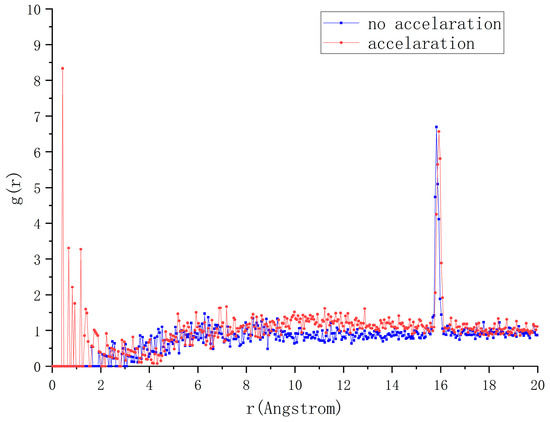
Figure 11.
Radial distribution function (RDF) between SBS and aromatic oil centres of mass.
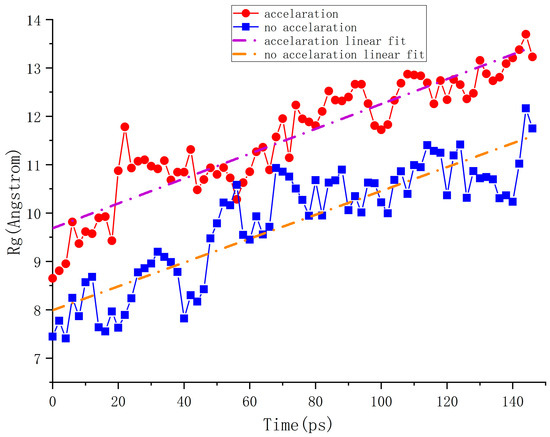
Figure 12.
Radius of gyration (Rg) curves of SBS molecules in conventional and accelerated systems.
As shown by the RDF curve, SBS molecules in the accelerated swelling system exhibit strong interactions with aromatic oils within a range of 2 Å, indicating that within this range, the accelerated swelling system exhibits a more pronounced aggregation effect than the conventional system. The RDF curves of the two systems show similar trends in the subsequent process, with the second peak positions being essentially the same, indicating that the accelerated swelling agent has good compatibility with SBS molecules. Observing the radius of gyration curves, it is found that the radius of gyration of SBS in the accelerated swelling system is generally larger than that in the conventional system, indicating that the SBS molecular chains in the accelerated swelling system are in an unfolded state, and the network structure formed by the accelerated swelling system is stronger than that of the conventional system. By performing linear regression on the rotational radius curves of both systems and calculating the slopes, the slopes for the accelerated swelling system and the conventional system were found to be 0.2569 and 0.2466, respectively, indicating that BPO and BPA molecules have the function of accelerating the swelling of SBS molecules.
By continuing to fit and calculate the MSD curves of SBS molecules in the modified asphalt system after equilibrium, the relevant diffusion coefficients can be obtained. The final 100 ps MSD data with a relatively stable slope after NPT ensemble equilibrium is used for fitting and calculation, as shown in Figure 13 and Figure 14.
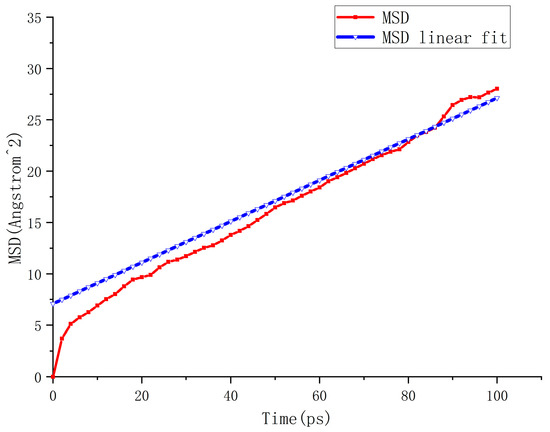
Figure 13.
MSD curve of the conventional SBS-modified asphalt system.
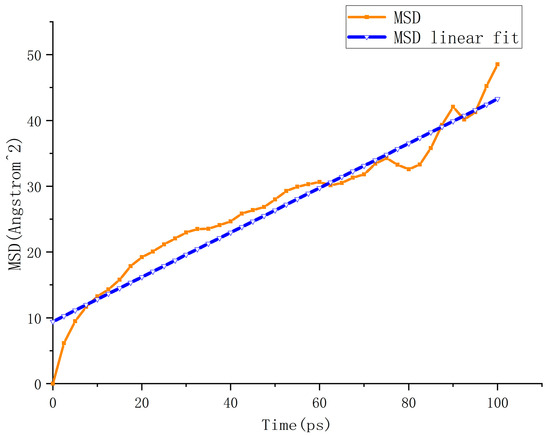
Figure 14.
MSD curve of the BPO/BPA-accelerated SBS-modified asphalt system.
According to the simulation results, the two curves represent the MSD over the final 100 ps, and the two blue straight lines are the linear fit lines for the two sets of MSD data. Figure 12 shows the asphalt diffusion system model for SBS without the addition of an accelerated swelling agent. Figure 13 shows the asphalt diffusion system model of SBS after adding BPO and BPA. The diffusion coefficients of SBS in modified asphalt under the two conditions were calculated using the slopes of the linear fitted lines of the two sets of MSD data, with results of 0.0334 and 0.0564, respectively. The goodness-of-fit coefficients of the lines were 0.9027 and 0.8443, respectively. The linear relationship of MSD is evident, indicating that BPO and BPA accelerate the diffusion of SBS in modified asphalt, suggesting that using BPO and BPA for accelerated swelling is feasible.
The slightly lower R2 values (0.9027 and 0.8443) observed in the modified asphalt system are attributed to the higher complexity and heterogeneity of real asphalt matrices, where multiple molecular species coexist and interact. The resulting dynamic fluctuations at the molecular interface cause minor deviations from ideal linear diffusion behaviour, which is consistent with previous simulation findings for multiphase bituminous systems.
The cohesive energy density and solubility parameters of the conventional system and accelerated swelling system of SBS mixed with aromatic oil, as well as the conventional system and accelerated swelling system of modified asphalt, were calculated, and the results are shown in Table 2.

Table 2.
Calculation results for cohesive energy density and solubility parameters.
The above results indicate that in both the SBS–aromatic oil blend and modified asphalt systems, the cohesive energy density of the accelerated swelling system is lower than that of the conventional system, suggesting that BPO and BPA enhance the compatibility and uniformity within the system. In both states, the difference in solubility parameters between the accelerated swelling system and the conventional system is less than 1.0 (J/cm3)0.5, indicating that BPO and BPA exhibit good compatibility with SBS and asphalt components, with no phase separation occurring. When the difference in solubility parameters (Δδ) between two materials is less than 1.0 (J/cm3)0.5, they are generally considered compatible, as suggested by Hansen’s solubility theory and polymer–solvent miscibility criteria [12].
5.2. Analysis of the Macro Effects of Accelerated Swelling
We conducted the softening point test in accordance with ASTM D36 using a softening point tester. We took 50 g of modified asphalt and poured it into a ring cup. We used a distilled water bath with an initial temperature of 5 °C and a heating rate of 5 °C/min. The temperature at which the steel ball presses the asphalt sample down to the specified position was observed. We conducted the penetration test in accordance with ASTM D5. We took 50 g of modified asphalt and poured it into penetration test cups. We placed the cups in a 25 °C constant-temperature water bath for at least 1 h to maintain a stable temperature. Using a standard penetration tester, we applied a 100 g weight and released the needle after it made contact with the asphalt surface for 5 s. The penetration depth (0.1 mm) was recorded, and we conducted the elongation test in accordance with ASTM D113. We took 70 g of modified asphalt and poured it into the standard elongation test mould, cooled it to room temperature, and placed it in a constant-temperature water bath at −10 °C for at least 1 h. The sample was stretched at a speed of 0.5 cm/min until it broke, and the maximum elongation length (cm) from the initial length of 30 mm to the point of breakage was recorded.
The modified asphalt parameters after testing are shown in Table 3.

Table 3.
Reaction mechanism test parameters for modified asphalt.
Through the above tests, it can be clearly seen that BPO weakens the physical cross-linking between SBS molecules by releasing free radicals, thereby promoting the absorption of light components of asphalt. BPA captures excess free radicals, inhibits excessive oxidation, and ensures a smooth swelling process. Under the synergistic action of BPO and BPA, the swelling efficiency of SBS is improved while avoiding performance degradation caused by increased oxidation; aromatic oil further enhances the compatibility between asphalt and SBS, improving low-temperature extensibility.
To quantitatively evaluate the accelerating effect of benzoyl peroxide (BPO) and benzoyl methane (BPA) in the swelling process of SBS-modified asphalt, a Brookfield viscometer was used to measure viscosity changes over time until swelling completion (viscosity stabilisation). Modified asphalt was prepared using the new process described in this paper and the conventional process, with strict maintenance of the same temperature and shear conditions. During preparation, a Brookfield viscometer was used to measure shear viscosity every 30 min at 115 °C, taking 50 g samples each time; testing continued until shear viscosity stabilised, indicating completion of swelling. The experimental results are shown in Figure 15 and Figure 16, depicting viscosity–time plots and swelling rate constant diagrams:
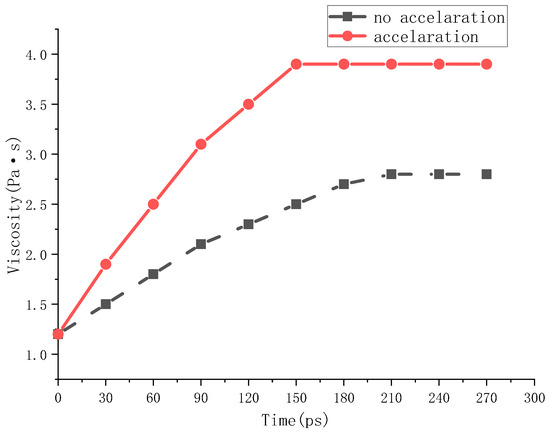
Figure 15.
Shear viscosity–time relationship for conventional and accelerated SBS-modified asphalt systems at 115 °C.
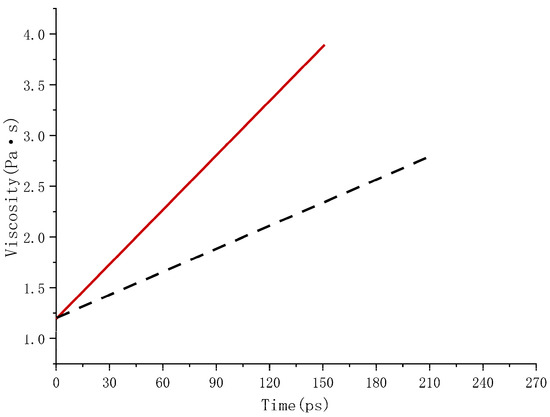
Figure 16.
Comparison of swelling rate constants (k) between conventional and BPO/BPA-accelerated systems.
As shown in Figure 15 and Figure 16, the black dashed line represents the test results for the conventional system without the addition of an accelerated swelling agent, while the red solid line indicates the test results for the accelerated swelling system. The experimental results indicate that the conventional process exhibits stable shear viscosity after 210 min, with a relatively slow swelling rate; the newly modified process using BPO and BPA achieves stable viscosity at 150 min, reducing swelling time by 40% compared to the unmodified process. The addition of BPO and BPA accelerates the increase in shear viscosity of the system. Within the first 45 min, the viscosity increase in the system with BPO and BPA reached 1.9 Pa·s, which is 2.1 times that of the conventional process (0.9 Pa·s); the additives significantly improved the swelling rate of SBS, while the viscosity stability value was 39% higher than that of the unmodified system, indicating that the system is more uniform and stable after swelling.
The swelling rate constant is defined as follows:
where
- Δη—viscosity increment;
- Δt—time increment.
Although k = Δη/Δt simplifies the swelling rate as a linear function of time, this approximation is valid within the early-stage region where viscosity increases nearly linearly [13,14]. For the later non-linear regime, the slope is recalculated in segmented intervals to account for viscosity stabilisation, ensuring that k represents the effective swelling rate rather than instantaneous viscosity fluctuations.
The swelling rate constant of the system prepared using the new modification process with BPO and BPA is 0.0076 Pa·s/min, while the swelling rate constant of the system with added BPO and BPA is 0.018 Pa·s/min, which is 2.37 times that of the conventional process. This indicates that BPO releases free radicals to promote the disintegration of the SBS network structure, enabling it to absorb asphalt light components more rapidly; BPA stabilises free radicals, preventing excessive cross-linking and ensuring a smooth swelling process; the synergistic effect of the two significantly shortens the swelling time while enhancing the final performance of the system. Changes in shear viscosity indicate that the additives promote the initial stage of swelling while ensuring higher and more stable final viscosity; testing viscosity changes using a Brookfield viscometer, which is an effective method for evaluating swelling rates, providing a scientific basis for optimising the preparation process of SBS-modified asphalt.
To investigate the impact of different amounts of benzoyl peroxide (BPO) and benzoyl methane (BPA) on the performance of modified asphalt, the following experiments were designed to compare the modification effects under different ratios. Benzoyl peroxide (BPO) dosage: set at 0.2%, 0.3%, 0.4%, and 0.5% (mass fraction relative to total asphalt mass). Benzoyl peroxide (BPA) dosage: set at 0.1%, 0.2%, 0.3%, and 0.4% (mass fraction relative to the total asphalt mass). Four groups of modified asphalt were prepared using the new process, with a focus on maintaining consistent temperature and shear conditions.
We conducted the RTFOT tests according to ASTM D2872. We took 300 g of modified asphalt samples, evenly distributed them into RTFOT test tubes, and controlled the sample thickness to within 3.2 mm to ensure uniform heating. The tubes were placed in the RTFOT test chamber, with the temperature set to 163 °C, air flow rate set to 4000 mL/min, and rotation every 15 s, for a test duration of 85 min, simulating the asphalt oxidation process at the construction site. The PAV test was conducted according to ASTM D6521. After completing the RTFOT test, the aged samples were uniformly applied to the PAV test discs, with a coating thickness of approximately 3.2 mm. The sample tray was placed in the PAV ageing chamber, with the ageing temperature set to 100 °C and an oxygen pressure of 2.1 MPa applied, for a test duration of 20 h, simulating a prolonged oxidation process.
The modified asphalt parameters after heating are shown in Figure 17.
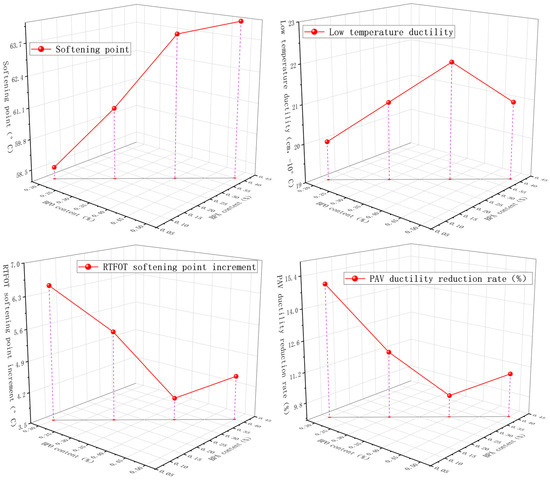
Figure 17.
Performance test parameters for modified asphalt.
Through the above tests, it can be observed that the softening point increases with the addition of BPO and BPA, particularly when BPO is 0.4% and BPA is 0.3%, reaching 64 °C, indicating an enhancement in the system’s viscosity; low-temperature extensibility improves with increased BPO and BPA content but slightly decreases when BPO exceeds 0.4%, due to a reduction in the system’s plasticity effect. The synergistic effect of BPA effectively prevents the adverse impact of excessive free radical reactions on low-temperature performance. RTFOT tests show that optimising the amounts of BPO and BPA significantly reduces the increase in softening point, indicating enhanced thermal–oxidative ageing resistance of the modified asphalt. In PAV tests, the rate of ductility reduction significantly decreases with increasing BPA content, indicating that BPA’s antioxidant effect effectively mitigates long-term ageing effects. Therefore, in this experiment, the modified asphalt exhibits optimal performance when the BPO content is 0.4% and BPA content is 0.3%.
Each test was repeated three times, and the average value with standard deviation was reported. The variations in swelling time and equilibrium viscosity were within ±5%, indicating acceptable reproducibility. Statistical analysis (t-test, p < 0.05) confirmed that the improvements in swelling rate and viscosity were significant compared with the conventional process.
6. Consideration of New Processes for the Preparation of Modified Asphalt Using BPO and BPA
To address the issue of excessive swelling time during the preparation of SBS-modified asphalt, this study proposes a method that utilises the synergistic effect of benzoyl peroxide (BPO) and benzoyl methane (BPA) to accelerate the swelling of SBS in asphalt. This method enables efficient swelling in a shorter time while significantly improving the high- and low-temperature performance and ageing resistance of the modified asphalt. The asphalt swelling acceleration method based on BPO and BPA, along with the modified asphalt preparation process, primarily uses the following materials: base asphalt, SBS thermoplastic elastomer, benzoyl peroxide, benzoyl methane, and environmentally friendly aromatic oil. The technology specifically involves the following four steps: preparation of asphalt adhesive paste, addition of swelling accelerator, shearing and swelling, and collection of the finished product.
While the proposed process shows promising laboratory performance, several factors should be considered for industrial application: BPO exhibits limited thermal stability above 200 °C and requires controlled storage and handling to ensure safety [15,16]. In addition, cost and sourcing of BPO and BPA may influence large-scale feasibility. Future work should focus on optimising dosage, ensuring thermal safety, and conducting pilot-scale trials to validate process scalability.
6.1. Materials and Reagents
Base asphalt: Meets road engineering standards, penetration 70 dmm (25 °C), softening point 46 °C.
SBS modifier: Linear styrene–butadiene–styrene thermoplastic elastomer, content of 4–5% by weight of asphalt.
Benzoyl peroxide (BPO): Addition rate of 0.1–0.5% by weight of asphalt; this study used 0.3–0.4%.
Benzoyl peroxide (BPA): Added at 0.1–0.3% of the asphalt weight; this study used 0.2–0.3%.
Environmentally friendly aromatic oil: Used to improve the compatibility between SBS and asphalt, added at approximately 2% of the asphalt weight.
In this experiment, to investigate the performance of the modified asphalt prepared using the new modification process described in this paper, the modified asphalt was prepared following the aforementioned process: 100 parts of base asphalt with a penetration of 90 dmm (25 °C) and a softening point of 48 °C were selected; 4 parts of SBS modifier, a linear styrene–butadiene–styrene thermoplastic elastomer (SBS) with a styrene content of 30%, were selected; 0.3 parts of benzoyl peroxide (BPO) as a free radical initiator were selected; 0.2 parts of benzoyl methane (BPA) as a free radical stabiliser were selected; and 3 parts aromatic oil to further enhance the compatibility between SBS and the asphalt matrix were selected.
6.2. Preparation Process
The preparation of accelerated swelling SBS-modified asphalt using BPO and BPA followed four main stages:
- (1)
- Asphalt pre-heating;
- (2)
- Addition of modifiers and accelerators;
- (3)
- High-shear swelling;
- (4)
- Product collection.
Detailed parameters (e.g., heating profiles, shear speeds, and dosage sequences) are provided in the Supplementary Materials.
The technical route is shown in Figure 18:
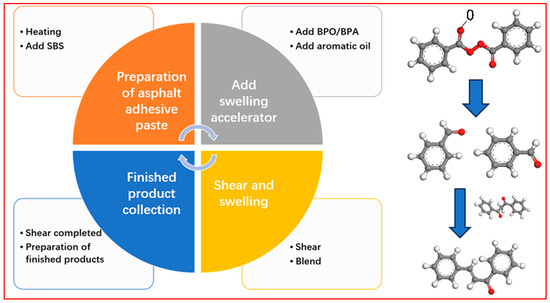
Figure 18.
Preparation process flowchart.
6.3. Characterisation Methods
The viscosity and low-temperature ductility of modified asphalt were characterised using softening point (ASTM D36), penetration (ASTM D5), and extensibility (ASTM D113). The ageing resistance of modified asphalt was characterised using the rotating thin-film oven test (RTFOT) and pressure ageing vessel test (PAV). Shear viscosity was measured at 115 °C using a Brookfield viscometer to characterise the viscosity–kinetic properties of modified asphalt. The test temperature of 115 °C was selected to represent the typical mixing and swelling temperature range for SBS-modified asphalt (110–120 °C), where SBS is sufficiently softened for diffusion without thermal degradation [17]. This temperature ensures measurable viscosity variation while avoiding oxidation or decomposition of additives.
7. Conclusions
The asphalt swelling acceleration method based on the synergistic effect of BPO and BPA proposed in this paper significantly accelerates the swelling process of SBS in asphalt through a radical initiation and capture mechanism.
(1) It was clarified that BPO generates free radicals at high temperatures, accelerating the diffusion behaviour of SBS, while BPA fixes free radicals and synergises with BPO to achieve accelerated swelling. The working mechanism of BPO and BPA accelerating SBS swelling was analysed.
(2) The micro- and macro-parameters for evaluating swelling effects were clarified, and molecular simulation calculations using MSD, RDF, Rg, and solubility parameters proved the feasibility of using BPO and BPA synergistically to accelerate SBS swelling.
(3) Through molecular dynamics simulations of the SBS–pre-swelling agent blend system, it was observed that the slope of the MSD curve increased and the value of the Rg curve rose, indicating that BPO and BPA can accelerate SBS swelling and help SBS form a stronger network structure. Through molecular dynamics simulations of the modified asphalt system, it was observed that the slope of the MSD curve increased, and the difference in solubility parameters before and after adding the swelling accelerator was less than 1.0 (J/cm3)0.5, proving the feasibility of BPO and BPA in accelerating SBS swelling.
(4) By measuring the viscosity–time curve, it was observed that the swelling time was reduced by 40% and the equilibrium viscosity increased by 39%, indicating that BPO and BPA can accelerate SBS swelling and make the swollen system more stable. Through performance testing of modified asphalt with different BPO and BPA dosages, the optimal ratio was identified based on the highest elongation, lowest increase in RTFOT softening point, and lowest reduction in PAV elongation. This indicates that a ratio of 0.4% BPO and 0.3% BPA achieves the optimal performance of modified asphalt.
(5) A new process for preparing modified asphalt using BPO and BPA was proposed, and a new scheme for preparing accelerated swelling modified asphalt for laboratory performance testing was provided. Methods for characterising the accelerated swelling effect during laboratory testing were also provided.
This technology significantly reduces production time and significantly improves the high-temperature stability, low-temperature flexibility, and anti-ageing performance of modified asphalt. This method not only has the advantages of energy saving, consumption reduction, environmental protection, and high efficiency but also provides new ideas for the industrial production of SBS-modified asphalt and a sustainable and industrially feasible solution for high-performance asphalt pavement.
This study primarily relies on molecular dynamics simulation and laboratory-scale experiments. The long-term field performance, environmental effects, and scalability of the BPO–BPA system have not yet been verified. Future research should integrate rheological ageing models and large-scale production validation to confirm practical applicability.
Supplementary Materials
The following supporting information can be downloaded at: https://www.mdpi.com/article/10.3390/buildings15213927/s1. Detailed experimental procedures for the preparation of accelerated swelling SBS-modified asphalt, including heating profiles, shear parameters, additive dosages, and sample conditioning steps, are provided in the Supplementary Materials.
Author Contributions
Conceptualization, Z.L.; data curation, Z.L.; writing—original draft preparation, Z.L.; project administration, Z.Y. and X.B.; validation, Z.Y.; writing—review and editing, Z.Y.; formal analysis, J.L.; funding acquisition, J.L.; investigation, X.B.; software, J.Y.; methodology, J.Y.; visualization, resources and supervision, C.Z. All authors have read and agreed to the published version of the manuscript.
Funding
This research was funded by China Construction 7th Engineering Bureau grant number [JTZB-YZKS-D081/2024] and the APC was funded by China Construction 7th Engineering Bureau.
Data Availability Statement
Data is contained within the article. The data presented in this study are available in insert article.
Conflicts of Interest
The authors declare no conflict of interest.
References
- Liu, H.; Zhang, Z.; Xie, J.; Gui, Z.; Li, N.; Xu, Y. Analysis of OMMT strengthened UV aging-resistance of Sasobit/SBS modified asphalt: Its preparation, characterization and mechanism. J. Clean. Prod. 2021, 315, 128139. [Google Scholar] [CrossRef]
- Kok, B.V.; Yetkin, Z.U.; Yalcin, E.; Yilmaz, M. Comparison of the preparation conditions for the modification of crumb rubber in laboratory and asphalt plant in terms of rheological properties. Constr. Build. Mater. 2024, 419, 135461. [Google Scholar] [CrossRef]
- Yan, K.; Zhang, H.; Xu, H. Effect of polyphosphoric acid on physical properties, chemical composition and morphology of bitumen. Constr. Build. Mater. 2013, 47, 92–98. [Google Scholar] [CrossRef]
- Han, X.; Mao, S.; Zeng, S.; Duan, H.; Liu, Q.; Xue, L.; Yu, J. Effect of reactive flexible rejuvenators on thermal-oxidative aging resistance of regenerated SBS modified asphalt. J. Clean. Prod. 2022, 380, 135027. [Google Scholar] [CrossRef]
- Li, J.; Yang, J.; Liu, Y.; Zhao, Z.; Tang, X.; Luo, J.; Muhammad, Y. Fabrication of IPDI-LDHs/SBS modified asphalt with enhanced thermal aging and UV aging resistance. Constr. Build. Mater. 2021, 302, 124131. [Google Scholar] [CrossRef]
- Luo, Y.; Zhang, H.; Chen, Z.; Li, Q.; Ye, S.; Liu, Q. Novel Multidimensional Composite Development for Aging Resistance of SBS-Modified Asphalt by Attaching Zinc Oxide on Expanded Vermiculite. Energy Fuels 2024, 38, 16772–16781. [Google Scholar] [CrossRef]
- Zhang, F.; Kaloush, K.; Underwood, S.; Hu, C. Preparation and performances of SBS compound modified asphalt mixture by acidification and vulcanization. Constr. Build. Mater. 2021, 296, 123693. [Google Scholar] [CrossRef]
- Wei, J.; Shi, S.; Zhou, Y.; Chen, Z.; Yu, F.; Peng, Z.; Duan, X. Research on Performance of SBS-PPA and SBR-PPA Compound Modified Asphalts. Materials 2022, 15, 2112. [Google Scholar] [CrossRef] [PubMed]
- Wang, Y.; Yi, H.; Cui, Y.; Li, S.; Zhou, S.; Yan, C. Research on the Preparation Process of SBS-Modified Asphalt Using Early Shearing Instead of High-Speed Shearing of Modifier. Appl. Sci. 2023, 13, 10335. [Google Scholar] [CrossRef]
- Guo, L.; Xu, W.; Zhang, Y.; Ji, W.; Wu, S. Selecting the Best Performing Modified Asphalt Based on Rheological Properties and Microscopic Analysis of RPP/SBS Modified Asphalt. Materials 2022, 15, 8616. [Google Scholar] [CrossRef] [PubMed]
- Guo, F.; Shen, Z.; Jiang, L.; Long, Q.; Yu, Y. Study on the Performance of Asphalt Modified with Bio-Oil, SBS and the Crumb Rubber Particle Size Ratio. Polymers 2024, 16, 1929. [Google Scholar] [CrossRef] [PubMed]
- Bagheri, R.; Ghaffari, M.; Shokrollahi, P. Evaluation of polymer blend compatibility based on solubility parameters and molecular dynamics simulations. J. Mol. Liq. 2020, 308, 113064. [Google Scholar]
- Wang, Y.; He, L.; Liu, Z. Energy-efficient preparation of SBS-modified asphalt by optimizing swelling kinetics. J. Clean. Prod. 2022, 380, 135078. [Google Scholar]
- Lee, S.H.; Kim, H.M.; Kim, D.H. Prediction of polymer–solvent compatibility using Hansen solubility parameters and molecular simulations. Polym. J. 2017, 49, 509–516. [Google Scholar]
- Liang, M.; Li, P.; Fan, W. Compatibility and phase behavior of SBS-modified asphalt based on Hansen solubility parameters and molecular dynamics. Fuel 2021, 304, 121463. [Google Scholar]
- Guo, R.; Zhang, X.; Zhou, J. Reactive modification of SBS asphalt using organic peroxides: Mechanism and performance evaluation. Fuel 2023, 341, 127755. [Google Scholar]
- Zhao, K.; Sun, Y.; Zhang, Y. Study on the swelling kinetics and morphology of SBS-modified asphalt using rheological analysis. Constr. Build. Mater. 2022, 329, 127152. [Google Scholar]
Disclaimer/Publisher’s Note: The statements, opinions and data contained in all publications are solely those of the individual author(s) and contributor(s) and not of MDPI and/or the editor(s). MDPI and/or the editor(s) disclaim responsibility for any injury to people or property resulting from any ideas, methods, instructions or products referred to in the content. |
© 2025 by the authors. Licensee MDPI, Basel, Switzerland. This article is an open access article distributed under the terms and conditions of the Creative Commons Attribution (CC BY) license (https://creativecommons.org/licenses/by/4.0/).